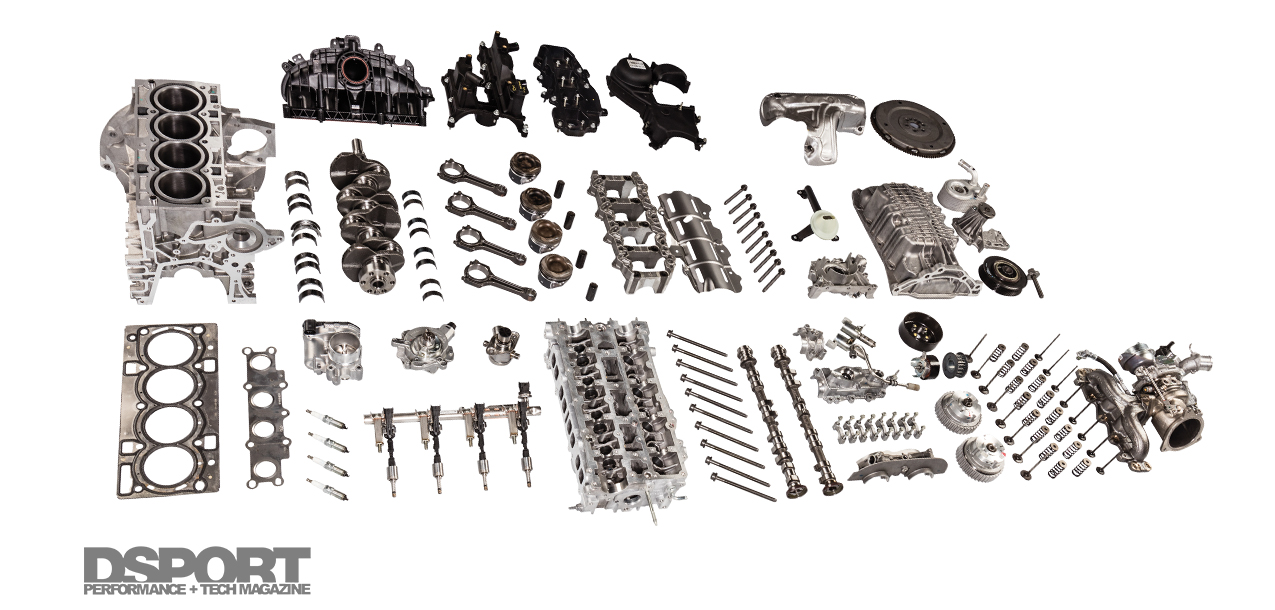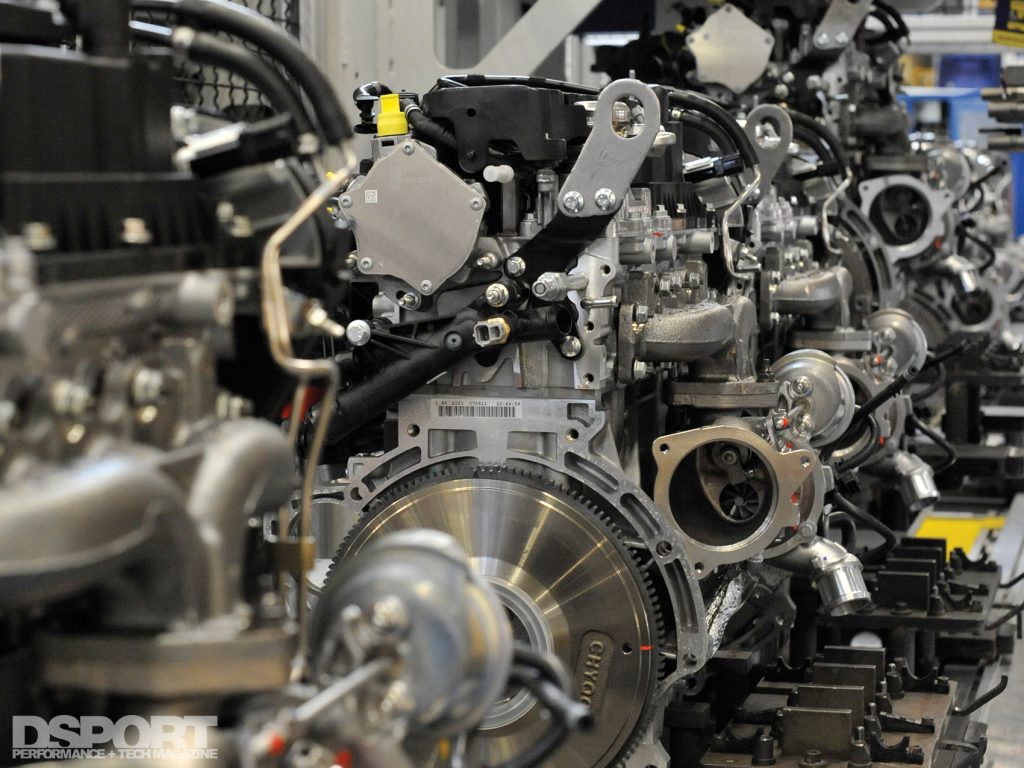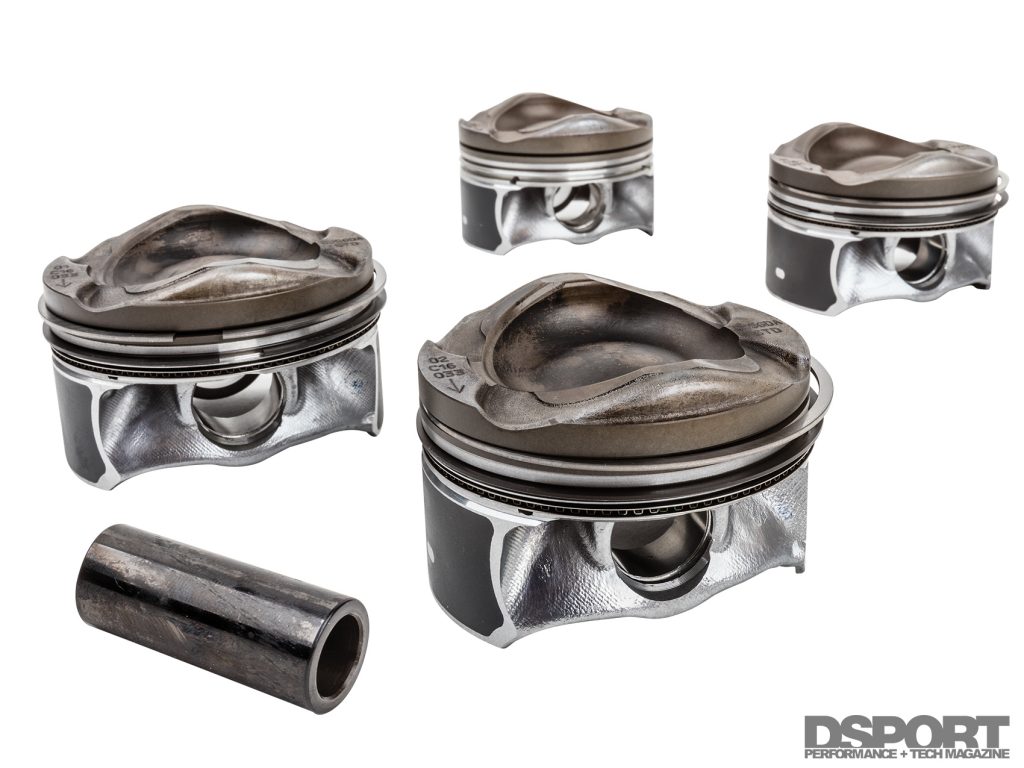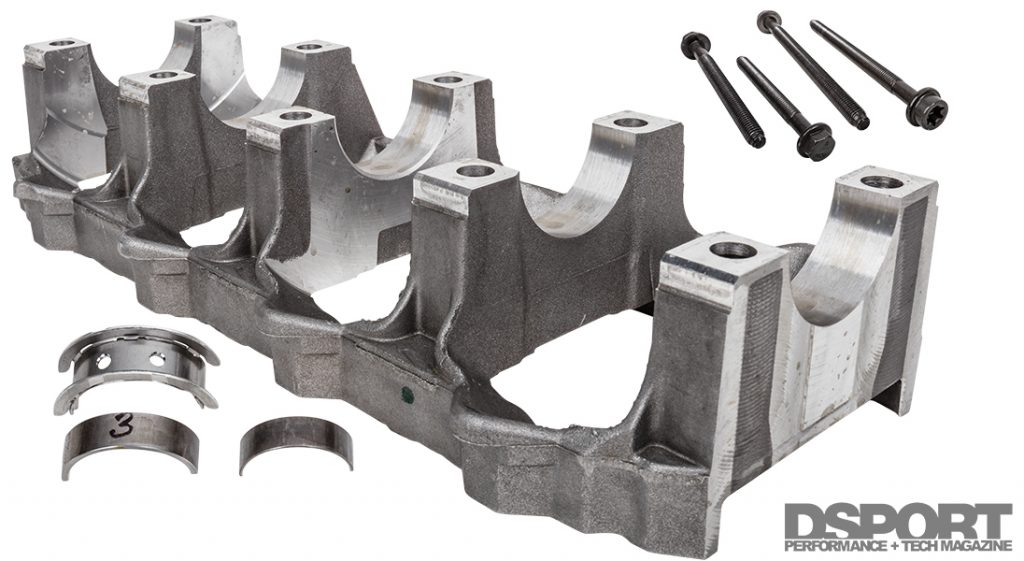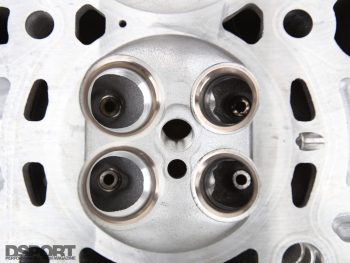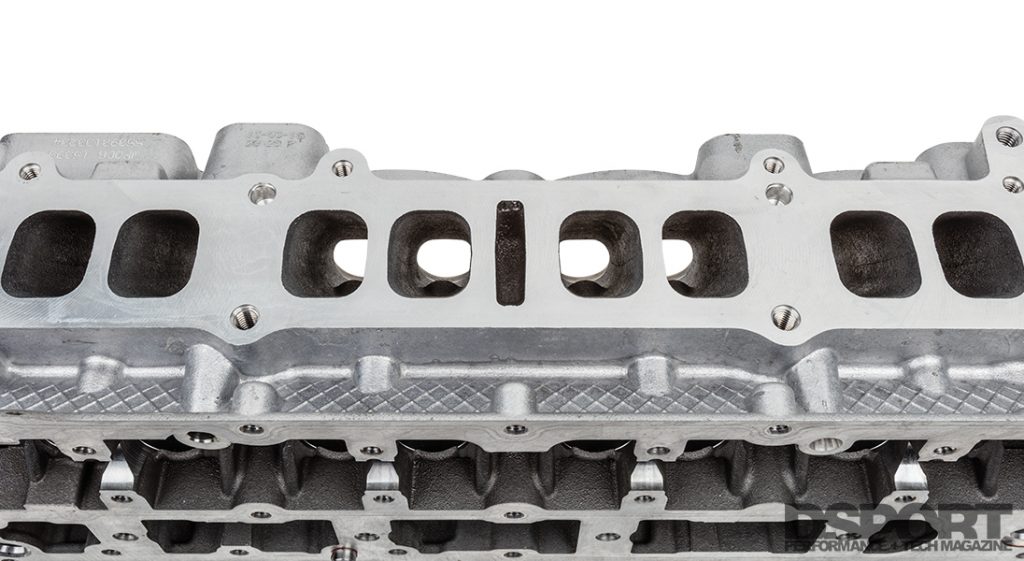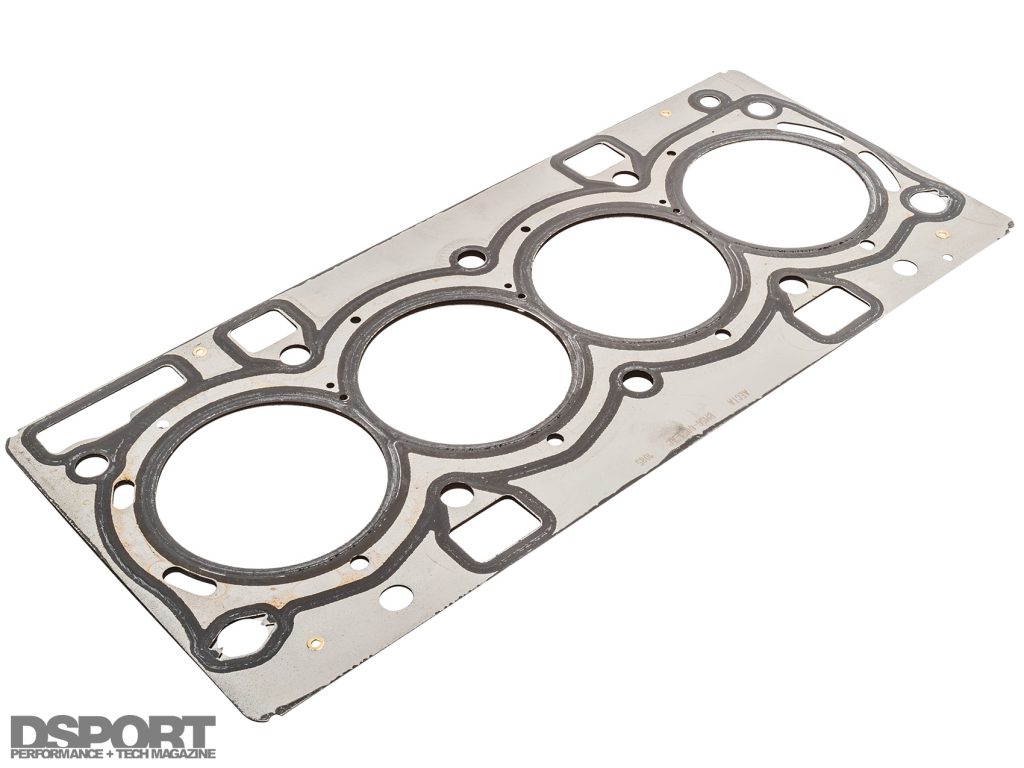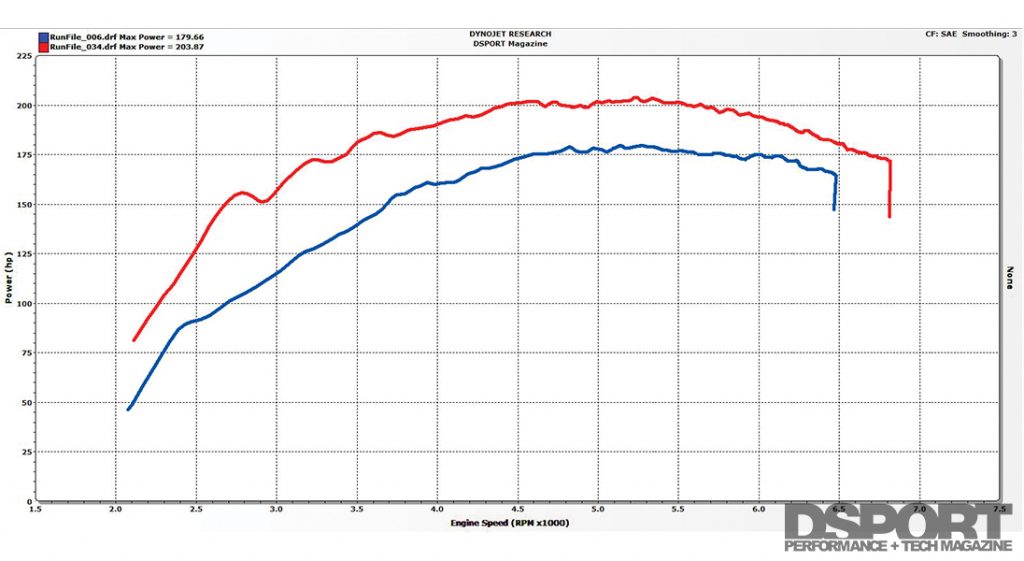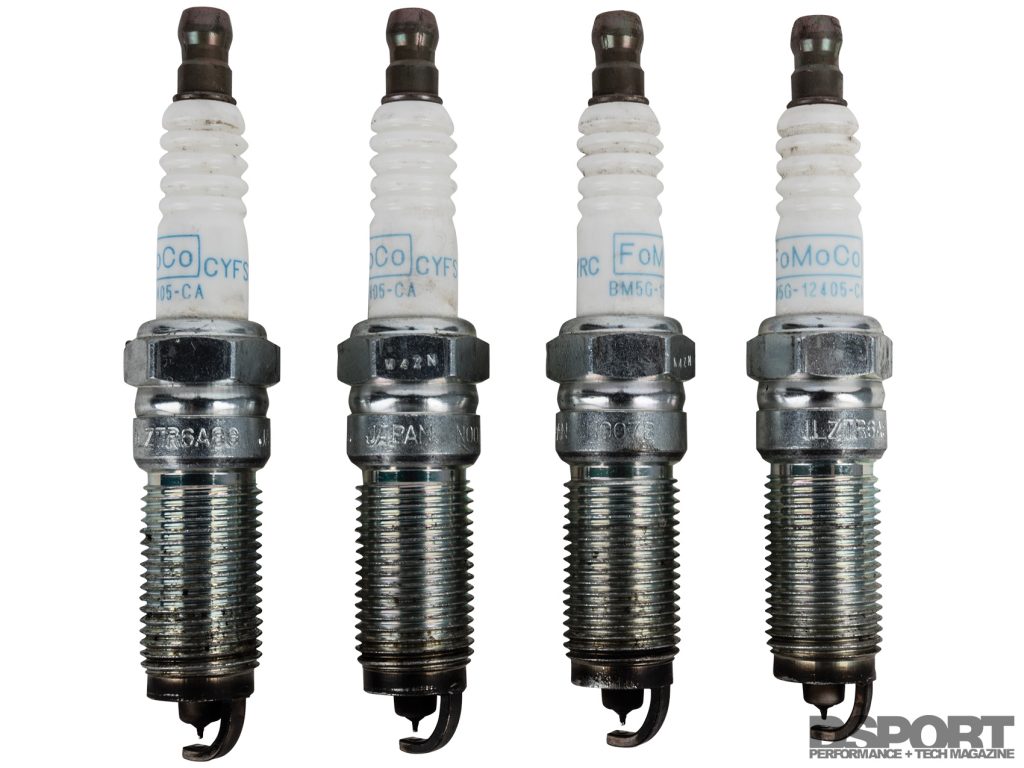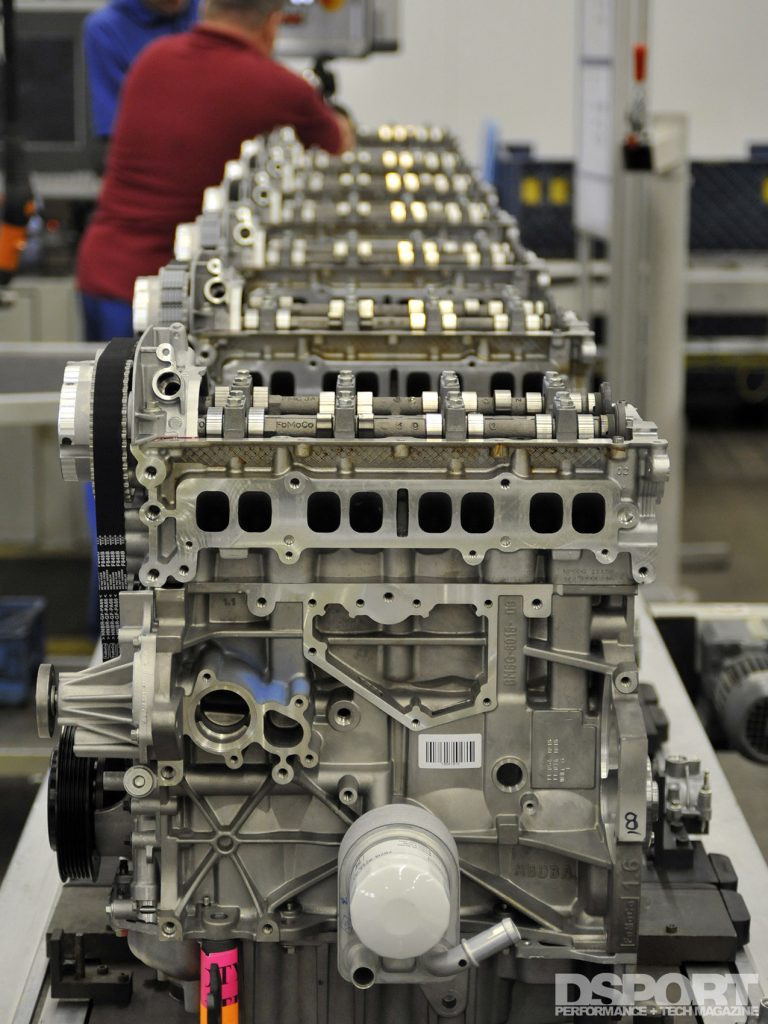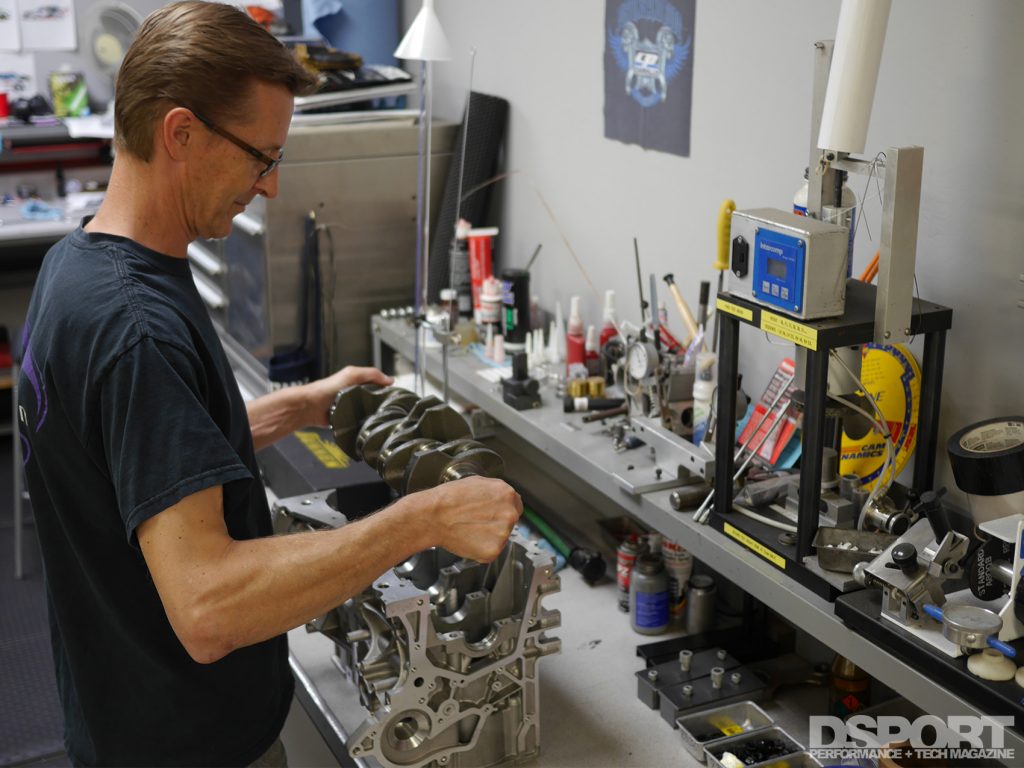Up until the release of the EcoBoost engine series, DSPORT has not had a reason to get excited about the four-cylinder offerings coming out of Detroit. Today, the EcoBoost family of four and six-cylinder engines from Ford are not only getting us excited, but they are also convincing generations of traditional performance enthusiasts that there are replacements for displacement. Engineering solutions to double or triple the output of an engine is nothing new for DSPORT. Before upgraded engine parts are designed, it’s imperative that a full understanding of the OEM foundation is known.
Text by Michael Ferrara // Photos by Cameron Parsons // Illustrations by Paul Laguette
DSPORT Issue #168
A line of 197-hp EcoBoost 1.6L engines wait for placement in a Fiesta ST
OEM Engineering and Under-/Over-Engineering
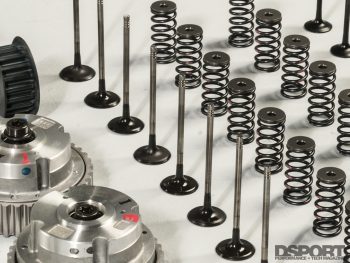 An engine is only as good as the sum of its parts. Every component in an OEM engine is expected to operate at a certain performance level for a set period without failure. The goal of the OEM engine parts engineer is to design, test and oversee the manufacture of the parts to deliver the performance and life needed within a set budget. Bean counters are a reality and some OEM engineering departments do a better job of getting higher budgets than others. Sometimes budgets force engineers to use the least expensive solution rather than the best solution. Low budget parts may use less expensive materials or less expensive manufacturing processes. The result are parts that are heavier, weaker or more susceptible to wear.
An engine is only as good as the sum of its parts. Every component in an OEM engine is expected to operate at a certain performance level for a set period without failure. The goal of the OEM engine parts engineer is to design, test and oversee the manufacture of the parts to deliver the performance and life needed within a set budget. Bean counters are a reality and some OEM engineering departments do a better job of getting higher budgets than others. Sometimes budgets force engineers to use the least expensive solution rather than the best solution. Low budget parts may use less expensive materials or less expensive manufacturing processes. The result are parts that are heavier, weaker or more susceptible to wear.
Under-Engineered
What does it mean for a part to be under-engineered? An under-engineered part is simply a part that could have been made tougher, lighter, more wear resistance or even made at a lower cost while still meeting the performance parameters. On the OEM level, under-engineered parts can sometimes result in expensive recalls. No OEM ever wants to have a recall, so the OEM engineers build in a safety factor (factor of safety in engineering terms) into the design of each part. If the computer models and math say that a M4 bolt is just enough to get the job done, an M5 or M6 bolt might be used instead to add a factor of safety.
Pushing the Envelope
If everyone was content with the performance of a factory vehicle, the world would be a duller place. Thankfully, not everyone has sold a piece of their soul and purchased an electric vehicle. For those wanting more out of life than to just live it, pushing beyond the factory performance levels will result in uncovering the parts not up to the task of supporting power levels that are 50-percent, 100-percent or over 200-percent more than the OEM level. Obviously, the parts engineered with a higher factor of safety are less likely to be the first to fail compared to those parts engineered with a smaller factor of safety. Our experience has revealed that most OEM engines appear to have a minimum factor of safety around 1.5 times the expected service level. It’s a big generalization, but most factory engines will live a long life when power isn’t increased beyond 50-percent of the original level.
Over-Engineered
The term “over-engineered” can be used to describe components that seems to have a higher power handling capability than needed. It can refer to parts with factors of safety that are double, triple or four times necessary under normal conditions. These are the OEM parts not needing an upgrade when the stakes are raised.
Teardown for the Lowdown
Looking at the exterior of an engine tells one very little. A thorough teardown, inspection and measuring session is a must just to get the basics in order. Looking to forums, Wikipedia and the Internet for accurate information can be a complete waste of time. If you are planning an engine rebuild, always source the OEM manufacturers service manuals for your exact year, make and model.
Of course, DSPORT Magazine and dsportmag.com are reliable sources for accurate information. Here’s a look at the FORD EcoBoost 1.6L in detail. Special thanks to Ford for supplying the engine. It’s our goal to build this 1.6L engine to thrive and survive at 400 whp. This build will be featured as soon as it is completed.
The EcoBoost 1.6L engine features an open-deck design that ensures adequate cooling of the cylinders. Notice the crosshatch finish in the cylinder bores.
By the Numbers | Ford EcoBoost 1.6L
CYLINDER HEAD
| Block Type | Aluminum Open Deck | |
| Main Housing Structure | Girdle/Beam Design | |
| Block Weight | 20.6kg | 45.3 lbs. |
| Displacement | 1596.2cc | 97.4 cu.in. |
| Bore/Stroke Ratio | 0.97:1 | Undersquare |
| Rod/Stroke Ratio | 1.646:1 | |
| Deck Height | 203.85mm | 8.025” |
| Cylinder Bore | 79.00mm | 3.1108” |
| Cylinder Bore Spacing | 87.00mm | 3.4258” |
| Cylinder wall thickness | 6.86mm | 0.270” |
| Main bore diameter | 54.00mm | 2.1260” |
| Cylinder finish | ||
| Ra | 10.6~13.3 µin | |
| Rz | 130~150 µin | |
| Rk | 20.5~33.5 µin | |
| Rpk | 11.0~16.0 µin | |
| Rvk | 31.0~38.0 µin | |
| Deck finish | Ra~15-22 µin | |
| Main bore finish | Honed | Honed |
–
PISTON
| Piston Diameter | 78.986mm | 3.1097” |
| Piston Construction | Cast w/Coated Skirts | |
| Piston-to-Wall Clearance | 0.028mm | .0011” |
| Piston Weight (w/o pin) | 250g | |
| Piston Ring sizes | ||
| Top | 1.2mm | |
| Second | 1.2mm | |
| Oil | 2.0mm | |
| Piston Ring Weights | 15.4g | |
| Piston Pin Weight | 79.0g |
HEAD GASKET
| Head Gasket Design | Dual-layer MLS w/stopper ring | |
| Head Gasket Bore Diameter | 79.75mm | 3.140” |
| Head Gasket Thickness | 0.5mm | 0.020” |
| Head Gasket Stopper Ring Thickness | 0.127mm | 0.005” |
CRANKSHAFT
| Rod C-to-C Length | 134.00mm | 5.2758” |
| Rod Weight | 407.0g | |
| Rod Small End Weight | 102.6g | |
| Rod Big End Weight | 304.4g | |
| Rod Small End Pin Diameter | 21.00mm | 0.8276” |
| Rod Big end housing diameter | 47.00mm | 1.8519” |
| Rod bolt diameter | M8x1.0 | |
| Crankshaft Stroke | 81.40mm | 3.205” |
| Crankshaft Weight | 10.2kg | 22.4 lbs. |
| Crank Rod pin size | 44.00mm | 1.7323” |
| Crank Main pin size | 48.00mm | 1.88975” |
| Crank Damper diameter | 133.00mm | 5.2360” |
CYLINDER HEAD
| Intake Runner Dimensions (8 total) WxH | 26x32mm | 1.03”x1.26” |
| Intake Runner Shape | Rounded Corner Rectangular | |
| Individual Cylinder Intake Runner Area | 16.7cm2 | 2.60in2 |
| Total Intake Runner Area | 67cm2 | 10.38 in2 |
| Valve Head Diameter, Intake | 30.00mm | 1.181” |
| Valve Stem Diameter, Intake | 4.966mm | 0.1955” |
| Exhaust Runner Dimensions (4 total) Dia. | 34.8mm | 1.370” |
| Exhaust Runner Shape | Round | |
| Individual Cylinder Exhaust Runner Area | 9.5cm2 | 1.47in2 |
| Total Exhaust Runner Area | 38.0cm2 | 5.88in2 |
| Valve Head Diameter, Exhaust | 25.00mm | 0.9843” |
| Valve Stem Diameter, Exhaust | 4.956mm | 0.01951” |
CAMSHAFT
| Camshaft Journal Size | 25.00mm | 0.984” |
| Camshaft Base Circle | 30.00mm | 1.181” |
| Intake Cam Max Lift | 7.9mm | 0.311” |
| Exhaust Cam Max Lift | 6.6mm | 0.260” |
| Intake L/D | 26.30% | |
| Exhaust L/D | 26.40% |
OTHER MEASUREMENTS
| Throttle Body Plate Diameter | 52.00mm | 2.047” |
Cylinder Block
Lightweight & Ribbed
The aluminum alloy engine block uses permanent mold technology with high-strength alloys. The block features thin-wall casting in low-stress areas to minimize weight. If this engine were a person, it would have under 10 percent body fat. Extensive ribbing adds to the skeletal strength in high stress areas. The engine’s “open-deck” design trades off some cylinder strength for lower weight, lower production costs and improved cooling balance and efficiency. A big unknown is how much power the factory cylinders can endure. We are betting that doubling the power on our build will still be within the capabilities of the factory cylinder walls. If not, aftermarket sleeves to the rescue.
Pistons
Hyper Cast w/DLC Pins
The OEM hypereutectic pistons were a pleasant suprise. The unmachined surfaces of these cast pistons have a near machined finish. Piston crowns and top ring lands feature a performance enhancing coating, while a friction-reducing coating is found on the asymmetrical skirts. Piston pins feature a diamond-like-coating (DLC) for exceptional wear resistance. These are some of the best OEM cast pistons we’ve ever seen. It wouldn’t suprise us if these pistons could survive in a 350hp or perhaps even 400hp engine.
Oil Pan
Oil Sump & Block Support
The primary purpose of an oil pan is to keep a continous supply of engine oil around the oil pump’s pickup assembly. On the EcoBoost 1.6L engine, the pan also adds structural support between the engine and the transaxle assembly.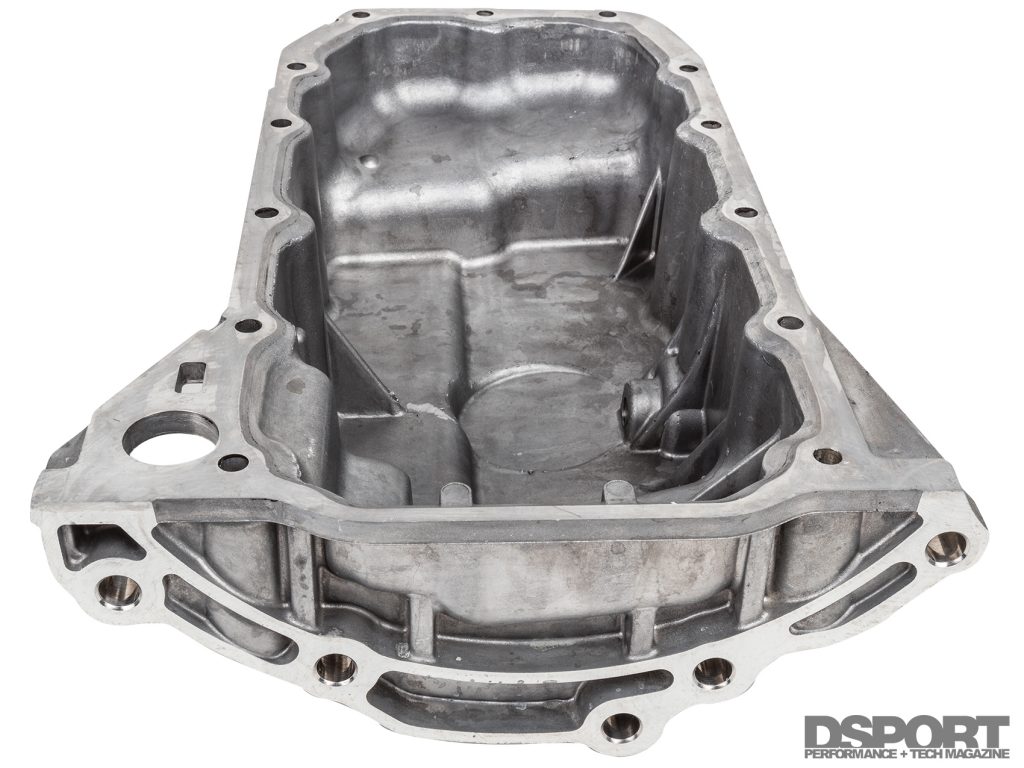
Made from what looks to be a permanent mold process, this aluminum oil pan also helps to add some rigidity to the block’s bottom.
Connecting Rods
Weakest Link Contender?
If you ever have to bet on what engine component will fail first when the power is increased, always bet on the connecting rods. While there are exceptions to the rule, the weakest links in most engines (including everything from the Honda D16 to the Nissan VR38) are the connecting rods or rod bolts. On the EcoBoost 1.6L, a hot-forged powder metal process and cracked rod cap process is used in the manufacturing process. While those processes add strength, we are concerned that the overall cross sectional area of the rod beams may not be enough. Additionally, the rod bolts are among the smallest diameter that we’ve ever seen and they are a torque-to-yield design than cannot be reused. To be safe, we’ll be upgrading the rods on our build.
Crankshaft
A Cast from the Past
We can’t recall the last time that we’ve seen an inline four-cylinder crankshaft that was manufactured by a casting process rather than a forging process. Forged Honda and Mitsubishi inline four-cylinder cranks have proven to handle in excess of 1,000 flywheel horsepower. The EcoBoost 1.6L engine uses a cast crankshaft. How much will it hold? We are going to see if 400 wheel horsepower is beyond its limits.
Crank Damper
Business as Usual
There is nothing out of the ordinary about the crankshaft damper. However, upgrading to an aftermarket SFI-approved damper will make the engine legal for competition in various racing classes. The aftermarket damper should also improve bearing and crankshaft life. Considering that the factory crank is cast, we consider a crank damper upgrade a must.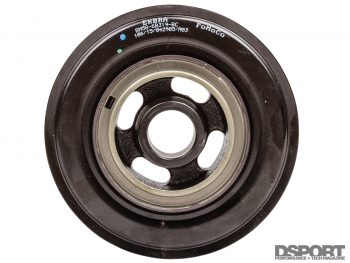
Main, Head Bolts & Bearings
Big Caps, Girdle & Three-Piece Thrust
The EcoBoost 1.6L features some massive main caps with an integral girdle system (a.k.a. beam). This is a very robust solution and we’ll probably come nowhere near its limits. The main studs are torque to yield and should not be reused. As always, we’ll look to ARP for a main stud kit solution and we’ll CNC vertically line bore the block for optimum crankshaft alignment in the block. A new generation three piece integrated thrust bearing is part of the main bearing solution.
Cylinder Head
16V High Velocity D-Ports
While some of the newer 4-cylinder engines incorporate a two-piece design to the cam journals (FA20, F20/F22C, etc.), the EcoBoost 1.6L keeps the lower cam journals as part of the casting. The cylinder heads ports, valve design and combustion chamber are designed for high-velocity flow and exceptional combustion efficiency. All eight Intake ports feature a visible “D” shaped design. These D-shaped intake ports allow the intake flow to be efficiently and quickly turned from the intake manifold into the cylinders with a minimal loss in flow velocity.
The cylinder heads rely upon shimless buckets that are available in 36 different thicknesses to set proper lash clearance. The bolts used to secure the cams and variable cam timing bridge are designed to be reused only once so we hope ARP makes an upgrade in the near future.
(Left) Here’s a look at the combustion chamber. Notice the center hole for the direct injection. (Right) The variable cam timing bridge is removed along with the rest of the valvetrain.
Camshafts
Twin Cams Direct the Action
The camshafts act directly upon the buckets without a rocker arm assembly. This direct acting setup improves performance and reliability. Since the engine uses a high-pressure mechanical fuel pump for the direct injection of fuel into the cylinders, one of the camshafts has an additional lobe to drive this mechanical high-pressure pump.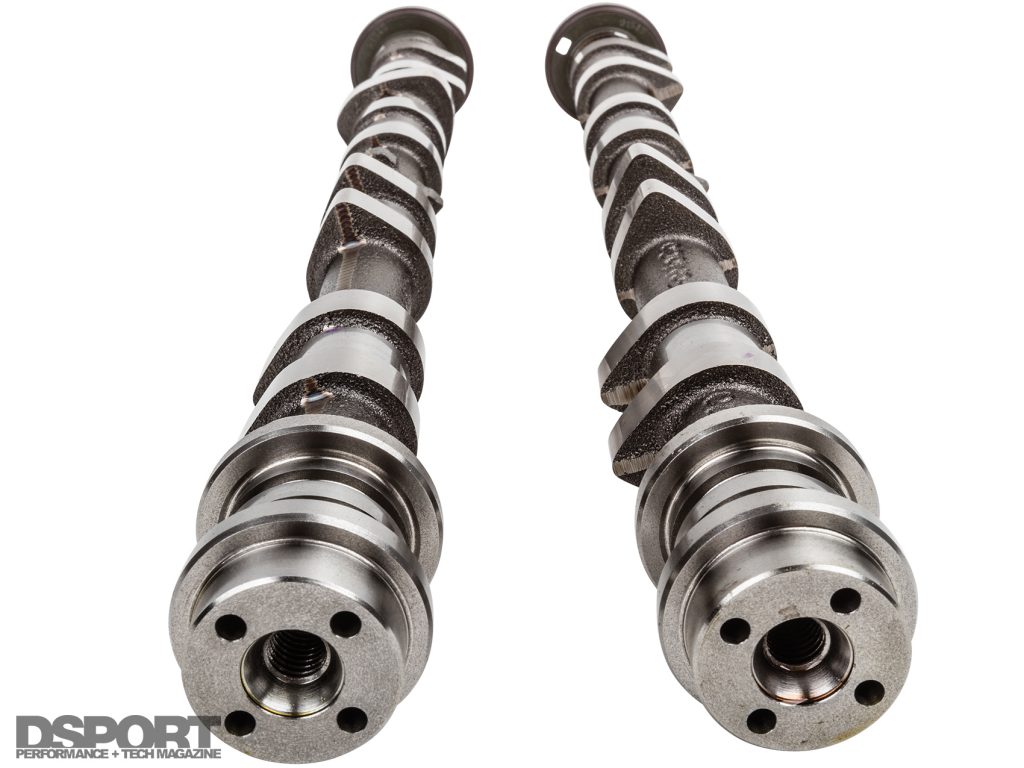
Cam Gears
Variable IN/EX Valve Timing
By having computer-controlled variable valve timing on both the intake and exhaust camshafts, the valve events can be optimized for peak performance, efficiency and emission reductions from idle to redline. As one would expect, the OEM design must optimize the cam timing to minimize engine emissions. When these engines are used in competition, the variable cam timing can be optimized for peak performance. The end result of this technology is improved idle quality, increased idle vacuum, reduced emissions, increased torque and power throughout the powerband and increased fuel economy.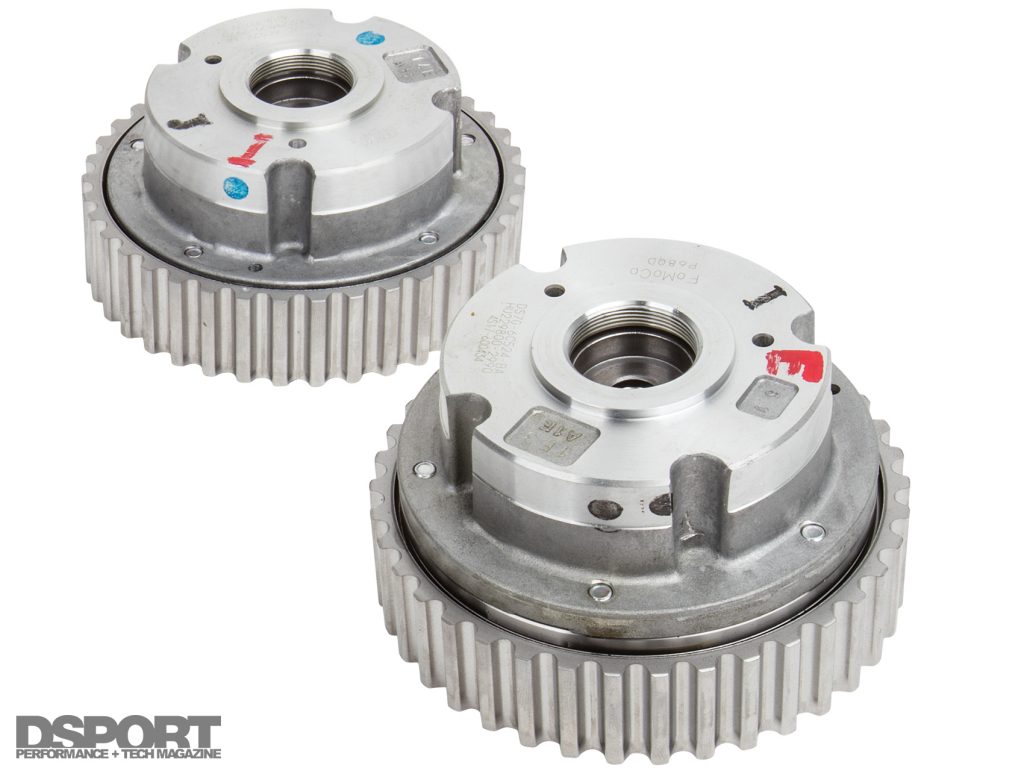
Valvetrain
Light is Right
As modern engines are turning to smaller and smaller valve stem diameters to maximize flow, the EcoBoost 1.6L features 5.0mm valve stems (the smallest we’ve seen, B-series Hondas are 6.5mm for comparison). Intake valves are 30mm in size while exhaust valves are 25mm. The intake valves feature a black-nitride coating for increased stem life.
Head Gasket
Multi-Layer Stainless Steel
The OEM head gasket is a multi-layer stainless steel (MLS) design that incorporates a sealing silicone.
Turbo System
No Turbo-Fold Here
Unlike some of the other engines in the EcoBoost family that use a “turbo-fold” turbocharger system where the turbine housing is cast as part of the exhaust manifold, the EcoBoost 1.6L keeps the turbine housing independent from the manifold. The turbo is a high-response Borg Warner unit with integral wastegate and compressor bypass. We opted to upgrade to a FULL-RACE manifold and Borg Warner EFR-series turbo for the ultimate in response and performance.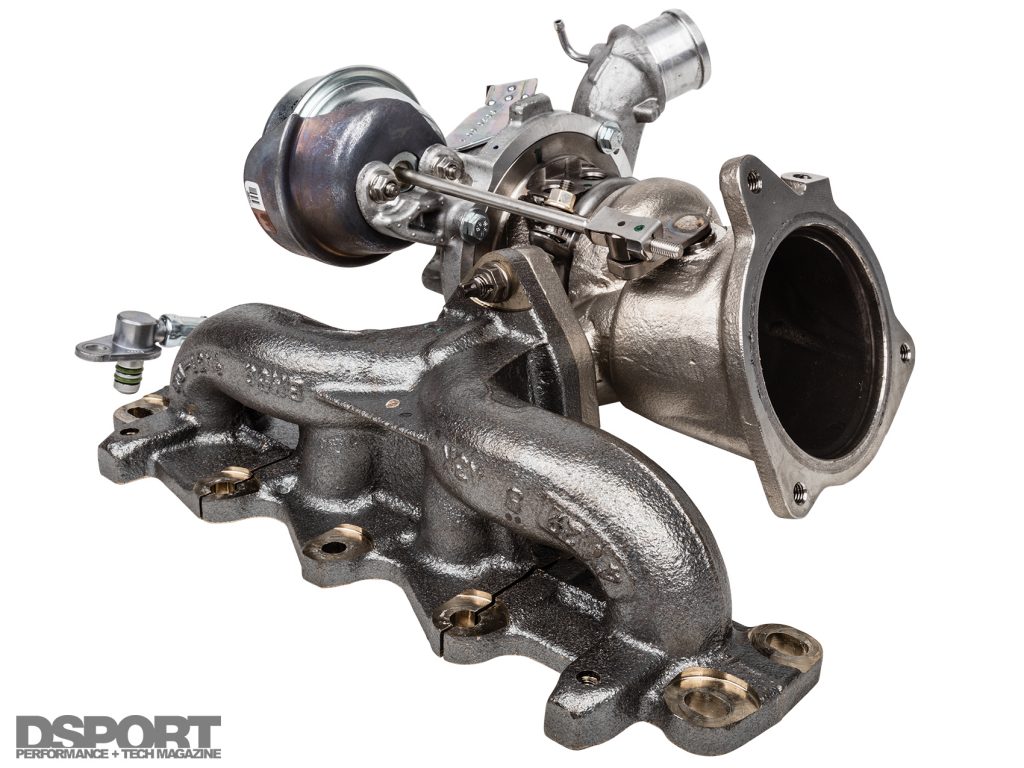
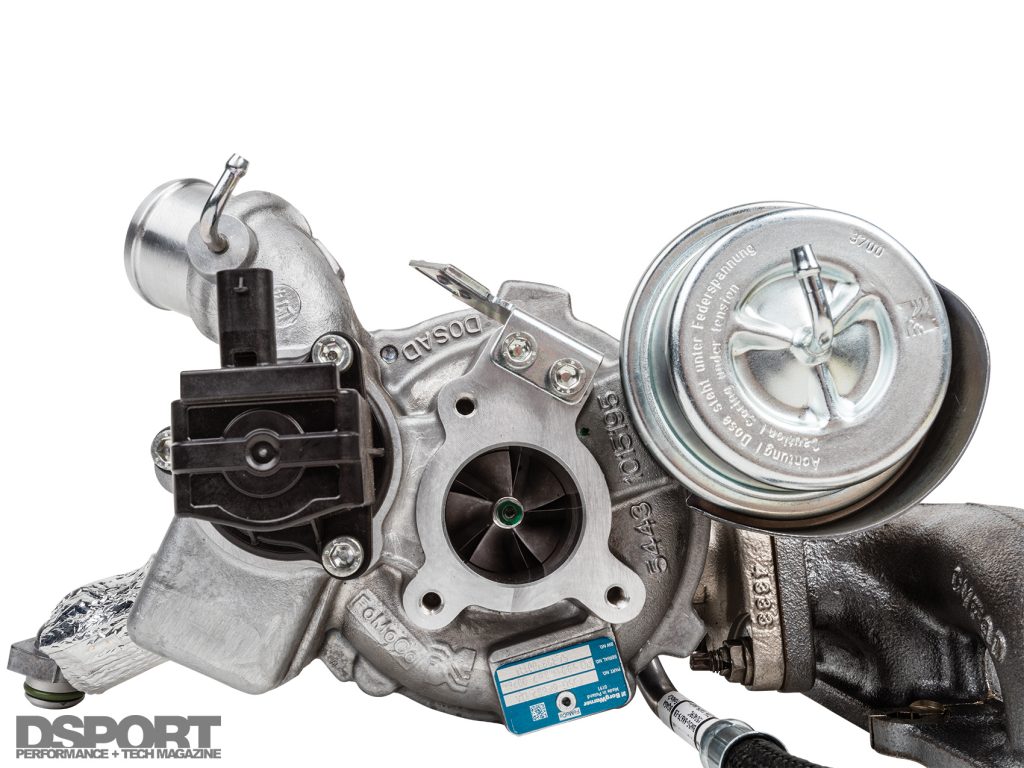
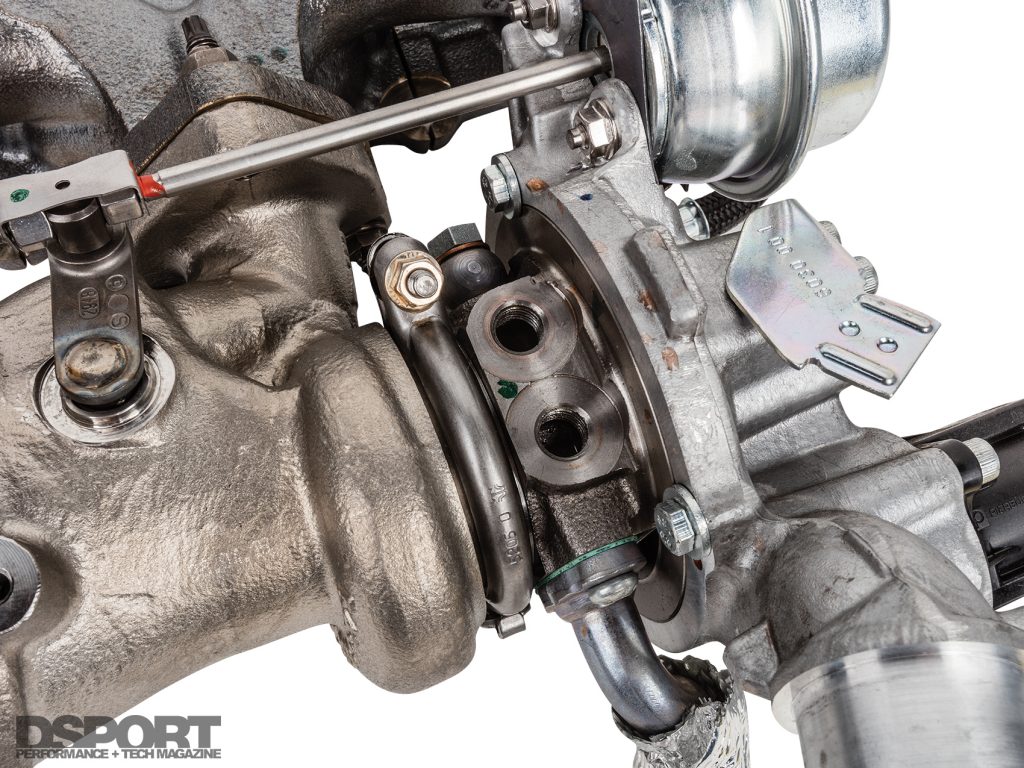 A water-cooled center section of the turbocharger. The chart shows the factory power output and maximum power output (bolt-on engine upgrades and boost levels increased) of the engine with the OEM turbocharger on 91-octane gasoline.
A water-cooled center section of the turbocharger. The chart shows the factory power output and maximum power output (bolt-on engine upgrades and boost levels increased) of the engine with the OEM turbocharger on 91-octane gasoline.
Actuators and Solenoid
Boost and Surge Control
Boost is regulated through a massive actuator and integral wastegate assembly on the turbocharger. The Fiesta ST employs a boost solenoid that modifies the signal into the actuator as needed. The ECU of the Fiesta ST also regulates the operation of the compressor bypass solenoid on the turbocharger. Since the ECU knows the exact throttle angle, manifold pressure and pedal input, it can optimize the actuation of the compressor bypass to eliminate compressor surge.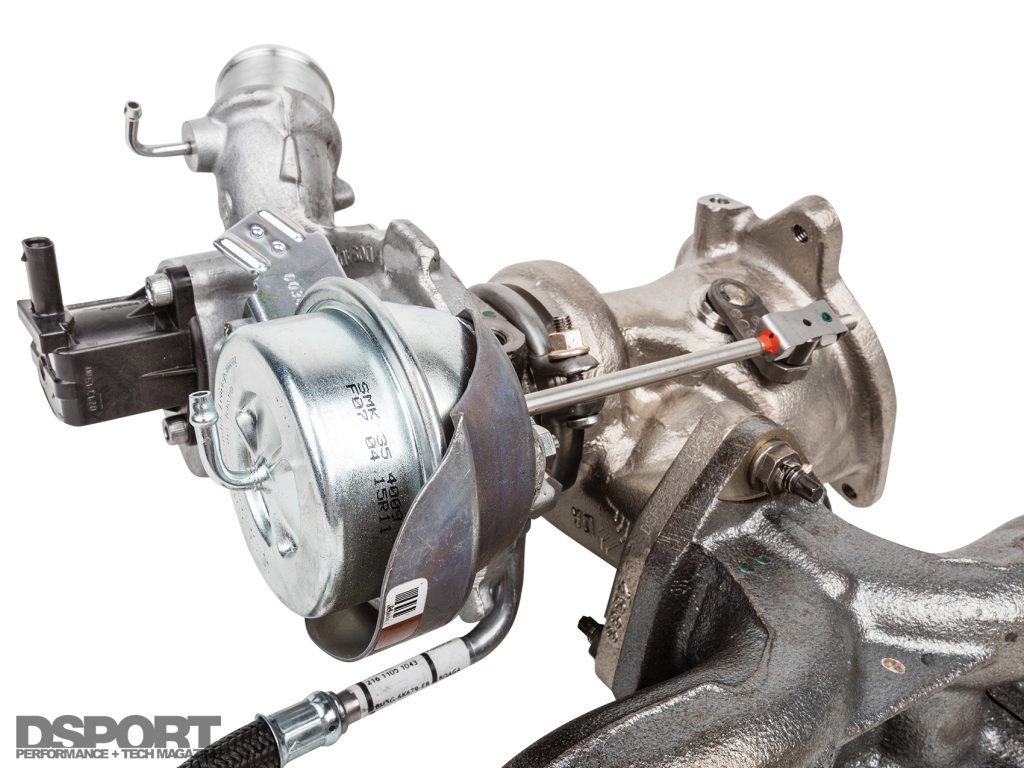
Throttle Body
Driven by Wires
The 52.0mm drive-by-wire throttle body is controlled by the ECU.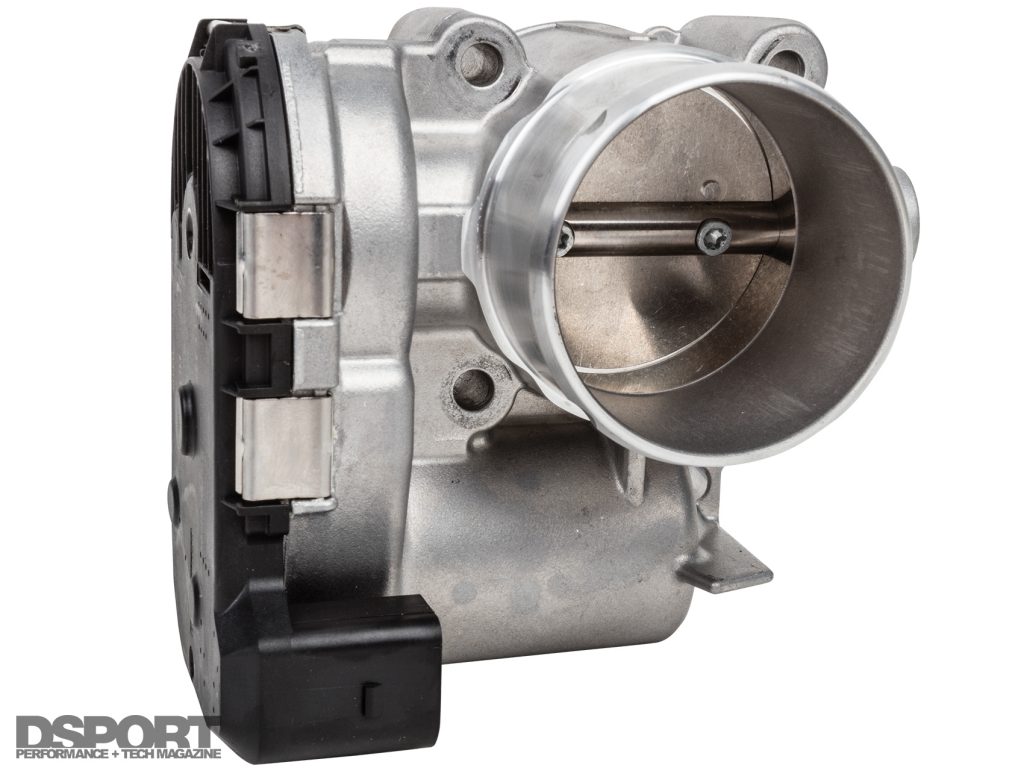
Intake Manifold
Plastic-Man!
Plastic intake manifolds are becoming more and more common on modern engines. While early plastic intake manifolds did not take kindly to aftermarket forced induction, this manifold was designed for a lifetime under boost. While it’s more cosmetically challenged than an aluminum variant, it should be able to get the job done.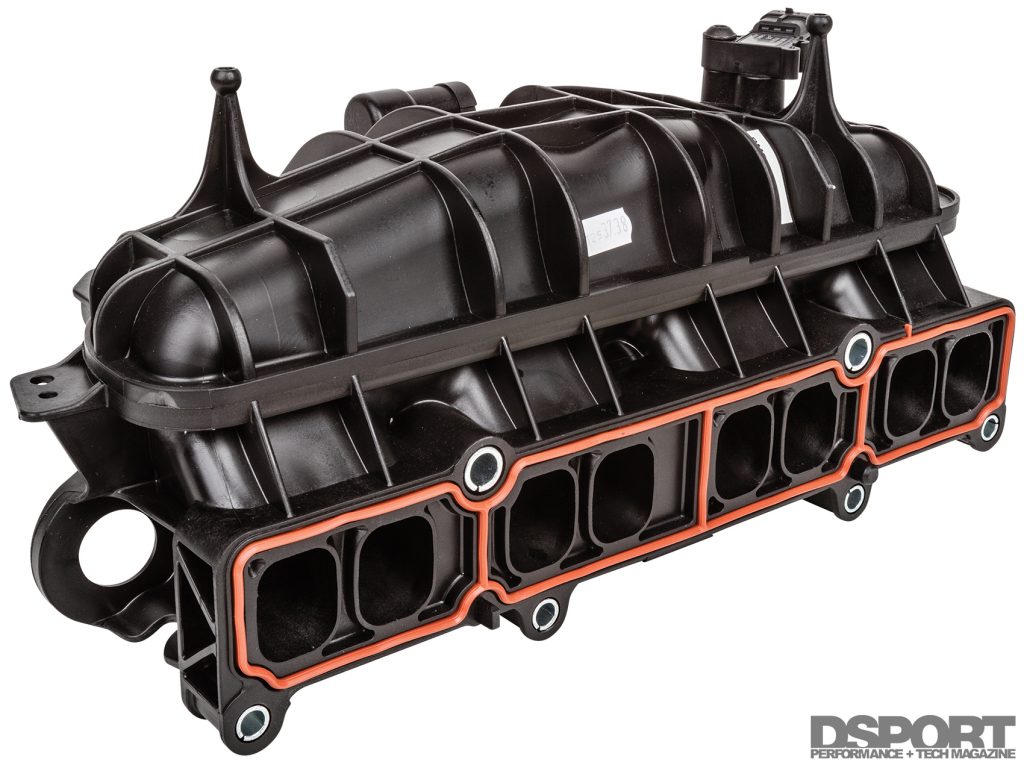
Fuel Rail and Direct Injectors
Performance and Efficiency Maximized
Direct injection allows superior atomization of the air-fuel mixture in the combustion chamber. This improved mixing allows for engines to run higher compression ratios for increased thermal efficiency. Unfortunately, the aftermarket is still playing catchup with direct injection and upgraded direct injection pumps, as injectors are only available on limited applications. Since no EcoBoost 1.6L direct injection upgrades currently exist, we’ll be adding a secondary port fuel injector system to meet our fuel demands at 400whp. As an added benefit, this fuel system will keep the backside of the intake valves clean.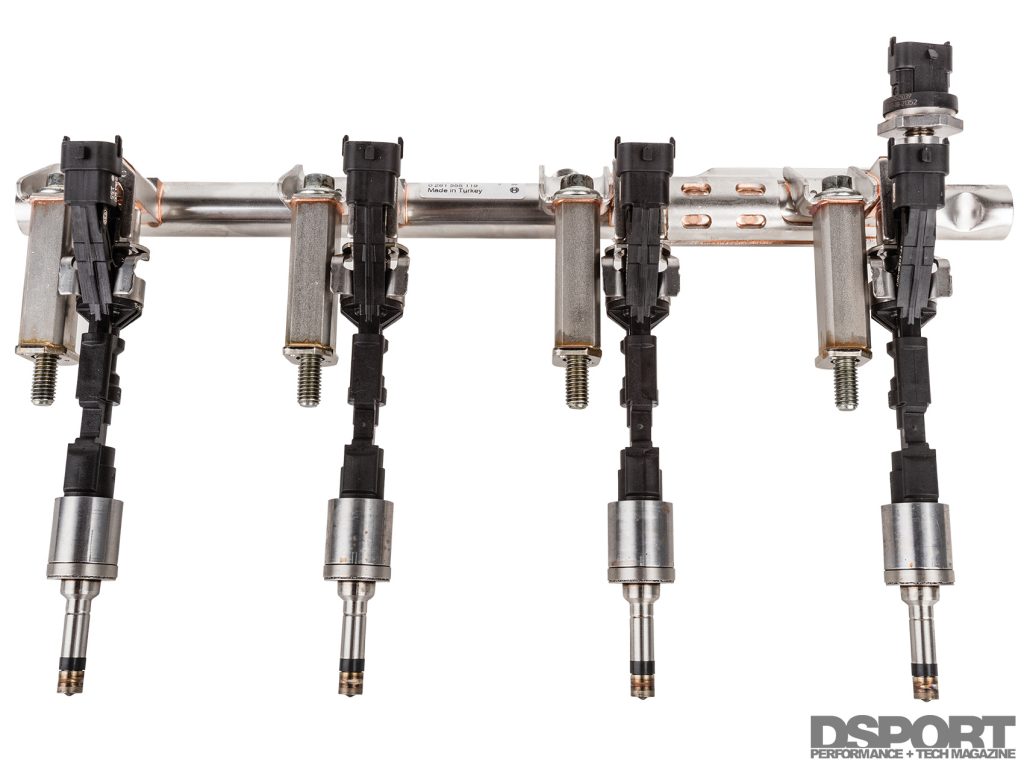
Spark Plugs
Iridium by NGK ILZTR6A8G
The spark plugs feature a laser-welded iridium electrode measuring just 0.6mm in diameter with the gap being set at 0.6~0.7mm. The combination of small center electrode and small plug gap allow the plug to fire under the extreme cylinder pressures of turbocharging. We’ll be using some NGK Racing plugs of the colder #8 range in competition.
Double or Nothing
Outlining our Plan for 400 WHP
As with any engine platform, there are components that we like and those that we’ll need to replace to reach our power goals. Aftermarket pistons and rods will eliminate the chance of failure in these areas. However, the cast crankshaft and open-deck block design of the EcoBoost 1.6L engine do cast a small shadow of doubt that we can reach our 400whp goal. Still, I’d rate our chance at 95 out of 100 to hit the mark. Considering the engineering, motorsports, machining and engine assembly experience that we have on staff at DSPORT, taking the EcoBoost 1.6L to new heights should be well within our pay grade.


